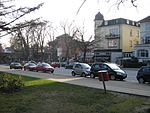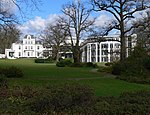Jenisch House
Art museums and galleries in GermanyBuildings and structures in Altona, HamburgHeritage sites in HamburgHistoric house museums in GermanyHouses completed in 1834 ... and 3 more
Manor houses in GermanyMuseums in HamburgNeoclassical architecture in Germany

Jenisch House (Jenisch-Haus) is a country house in Hamburg built in the 19th century and an example of Hanseatic lifestyle and neoclassical architecture. As of 2008, Jenisch House is the home of the Museum für Kunst und Kultur an der Elbe. It is located within the Jenisch park in the Othmarschen quarter.
Excerpt from the Wikipedia article Jenisch House (License: CC BY-SA 3.0, Authors, Images).Jenisch House
Baron-Voght-Straße, Hamburg Othmarschen (Altona)
Geographical coordinates (GPS) Address Phone number Website Nearby Places Show on map
Geographical coordinates (GPS)
| Latitude | Longitude |
|---|---|
| N 53.5525 ° | E 9.8655 ° |
Address
Jenisch Haus Stiftung Historisches Museum Hamburg
Baron-Voght-Straße 50
22609 Hamburg, Othmarschen (Altona)
Germany
Open on Google Maps










